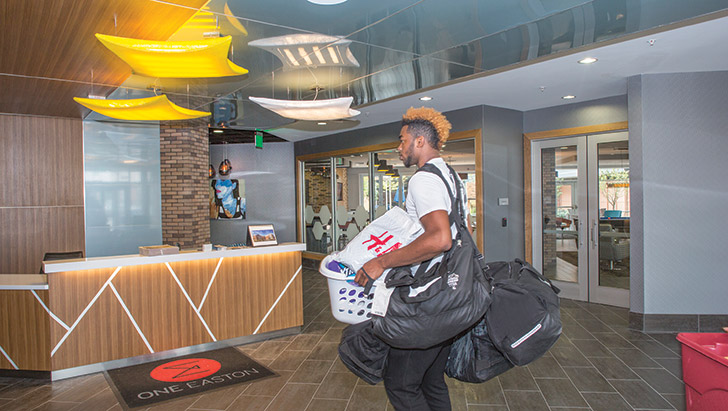By Kathy Canavan (Delaware Business Times)
Newark’s newest 440-bed student apartment high-rise offers students jaw-dropping amenities parents might not have — keyless entry, granite countertops, stainless steel appliances, 43-inch HD TVs, and a bathroom for every bedroom. The six-story building has a slogan: “Live Above the Rest.”
When the residents talk about “the grind,” they’re referring to the in-house coffee bar.
Outside, there are barbecue grills, hammocks, a heated outdoor activity pavilion, a parking garage and an 80-inch outdoor television. Inside, there are furnished apartments with bedroom-bathroom parity, a study lounge, a computer center, an expansive game room, a 24-hour fitness center with a cardio theater that allows students to watch individualized entertainment options while they work out.
The cherry on the sundae is mixers and networking sessions for residents, arranged by Campus Advantage, the company that manages the building for The Bainbridge Companies and Pinecrest Partners, who jointly own the company.
As of Sept. 1, occupancy was at 86 percent, below the 95 percent sweet spot for student housing, but the building is near Newark Shopping Center, an 11-minute walk from the central campus, and several closer amenity-laden small buildings have come on line in the past two years.
“We’re still building our occupancy. We typically want to be in the mid-90s, but we’re pleased with that figure and looking forward to growing that number,” said Christy Shorter of Campus Advantage. “This is a great market. There’s a lot of enthusiasm for the product. We’ve just been building our brand awareness this first year.”
Caroline Forehand, vice president of marketing for Bainbridge Companies, said the developers put much effort into setting up a social network so residents mingle with other residents and creating design features students would enjoy. “The fitness center and the study give you the wow factor when you walk in,” she said.
One Easton, where two-bedrooms range from $915 to $1,157 per bed, is a hybrid building that rents to students and young professionals. The current mix is about 60 percent students, said Jay Perez of Campus Advantage.

Harry Perlmutter, director of marketing at Pinecrest Partners, points to One Easton as an example of the opportunities available to developers and University communities alike. “When the right team of ownership and management work in creative synergy as they have here, you’re able to provide students with the very best in quality in close proximity to leading University campuses, which has always been Pinecrest’s strategic focus,” he said.
There’s no shortage of trendy options for the 58 percent of UD undergrads who live off campus. In the past five years, new or do-over housing has featured hardwood floors, bathroom-bathroom parity, pet-friendly units, even Craftsman-style bungalows. Many, like One Easton, developed by Pinecrest, offer individual leases that include most utilities, so there’s no waiting for the cable man.
Students are flocking to newer housing offerings with one-to-one bedroom-bathroom parity, said Corey Lonberger, managing partner for Rittenhouse Realty Advisors of Philadelphia, who follows the Delaware market. “That’s a big thing with students now. They want to have their own space, and they’re willing to pay up for it,” he said.
Student housing is generally a safer bet for developers than other apartment types because there’s a steady supply of customers. At UD, management companies scramble to lease in January and February for the following September.
“It’s very seasonal. If you miss it, you can have difficulty filling those up,” said Lonberger. “And, if you’re not leased up now, you could be in trouble.”
Although the ultimate goal is to hit 95 percent occupancy, Lonberger said landlords who are at 90 percent occupancy or above are doing just fine.
Students often jump from place to place as newer, shiner options open. That leaves apartments on the lowest end vacant. “The last tier is always the one that gets hurt, so what we’re seeing it they maybe concess on some of their rents so they can keep the occupancy up,” Lonberger said. “Whenever you have product from the 1950s to the 1970s, you have to do whatever you have to get those occupied. What we’re seeing at UD is maybe they’ll give a free month’s rent, maybe a month and a half.”
When apartments don’t rent to students, landlords often turn them into market-rate housing for rent to UD employees and Newark residents. “Typically that’s a negative, because the students are always paying more than what a resident would,” Lonberger said. “Typically it’s a huge hit when a property has to go from student to non-student.”
Future buildings are restricted by the amount of open land bordering the central campus. As one Newark businessman put it, “There’s just no more room. Where are you going to put it, unless they tear something down. The kids won’t go far. The ones that are close to campus are the ones that fill up.”


Recent Comments